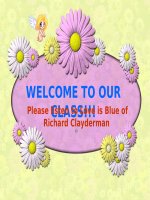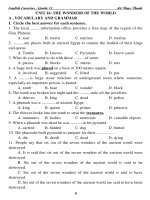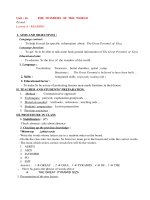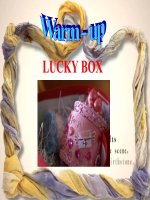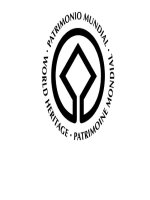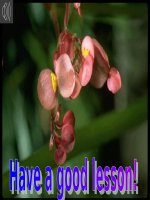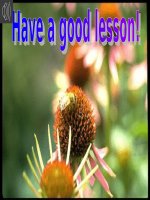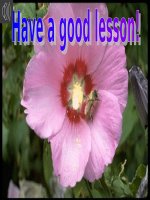Unit 16
Bạn đang xem bản rút gọn của tài liệu. Xem và tải ngay bản đầy đủ của tài liệu tại đây (156.29 KB, 13 trang )
<span class='text_page_counter'>(1)</span>UNIT 16. MAN AND THE ENVIRONMENT. DIVISION OF THE LESSONS Period 98 Lesson 1: A1, 2 Period 99 Lesson 2: A 3 Period 100Lesson 3: B 1 Period 101Lesson 4: B2, 3 Period 102Lesson 5: B4, 5 Period 103 Grammar Practice Date: April 25th, 2012 UNIT 16: MAN AND THE ENVIRONMENT Period: 98 Lesson 1: A1-2-3.Animals and plants I. Aim: By the end of the lesson, students will be able to know about countable and uncountable quantifiers: a lot, a little, a few to talk about Food. II. Language contents Vocabulary: a little, a few, to grow, to produce, animals, buffalo, cow - Model sentences : some A lot of + countable noun A few of some A lot of + uncountable noun A little III. Techniques Pictures drill, mind map, prediction IV. Teaching aids Pictures, cassette player, posters V. Procedures Teacher and students’ Contents activities I. Warm up: mind map / Marks Teacher: asks Students tell some foods Students: write on the board (Correct themselves). Teacher: presents new words by pictures Students: listen and repeat. II. Pre reading a) Pre- teach: a little,.
<span class='text_page_counter'>(2)</span> Teacher: asks Students to guess Students: work in pairs. Teacher: presents structures Students: listen and practice in pairs. a few, to grow, to produce, animals, buffalo, cow * Guess from the text 6 things Mr. Hai 5 things he has on his farm produces - …………… - …………… - …………… - …………… - …………… b) Structures some A lot of + countable noun A few of some a lot of A little. Teacher: asks Students to listen to the tape again Students listen and read individually. + uncountable noun. III. While reading A.1/P166 * Picture drill A3/ 166, 167. Mr. Hai has… Paddy fields, a small vegetable field, fruit trees, buffalo, cows, chickens. Mr. Hai produces… Rice, vegetable, fruit, milk, eggs. Teacher asks Students to practice Answer keys: asking and answer the questions 1.He produces a lot of rice 2. Yes, he does. Students practice in pairs 3. He produces a little fruit 4.His cows produce a little of milk Teacher asks Students to look at 5. His chickens produce a lot of eggs. IV. Post - reading /Marks the pictures Discuss about Mr. Hai Students read sentences and Ex: practice in pairs 1. What does Mr. Hai do? Students: to read the text and check their answers.
<span class='text_page_counter'>(3)</span> Students work in groups of four to discuss about Mr. Hai. They make questions and answer them.. - He is a farmer. 2. Where does he live? - He lives in the house in the country. 3. What is there near his house? - There is a small field. 4. What animals does he have? - He has buffaloes, cows, a dog, a cat and chicken. 5. What vegetables does he grow? - He grows rice, fruit trees and vegetables. V. Homework -Practice A2 again -Do exercise A1,2,3(WB) -Prepare A 3. Comments .......................................................................................................................... .......................................................................................................................... .......................................................................................................................... ........................................................................................................................... Ngày 19 tháng 04 năm2012 To truong. Huynh thi Kim Loan. Date: April 25th, 2012 UNIT 16: MAN AND THE ENVIRONMENT Period: 99 Lesson 2: A 3.Animals and plants I. Aim: By the end of the lesson, students will be able to listen and write the letter of the pictures under the right heading. II. Language contents Vocabulary: a duck, a chick Grammar: had III. Techniques Word cue drill, board drill, comprehension questions. IV. Teaching aids.
<span class='text_page_counter'>(4)</span> Pictures, cassette player, posters V. Procedures Teacher and students’ Contents activities I. Warm up / Marks Teacher: asks Students 1. Old McDonald to play a game Old Macdonald had a farm, E-I-E-I-O Students: listen to a And on his farm he had a cow, E-I-E-I-O song and find out the With a "moo-moo" here and a "moo-moo" name of the animals in there it. Here a "moo" there a "moo" (Correct Everywhere a "moo-moo" themselves) Old Macdonald had a farm, E-I-E-I-O Old MacDonald had a farm, E I E I O, And on his farm he had some chicks, E I E I O. With a chick (chick) here and a chick (chick) there, Here a chick, there a chick, everywhere a chick (chick). Old MacDonald had a farm, E I E I O. Old MacDonald had a farm, E I E I O, And on his farm he had a duck, E I E I O. With a quack (quack) here and a quack (quack) there, Here a quack, there a quack, everywhere a quack (quack). Old MacDonald had a farm; E I E I O. Old MacDonald had a farm, E I E I O,. Teacher: reminds students of using some, a few, a lot of, a little. Students: listen and repeat. II. Pre- listening a) Review: some A lot of + countable noun A few of some a lot of A little b) Guess:. + uncountable noun.
<span class='text_page_counter'>(5)</span> Teacher: shows a mind map Students: predict something they are going to listen. Teacher plays the computer Students listen Students check their answers. Teacher asks Students to write the sentences they hear.. III. While - listening a. some b. a few c. a little d. some e. a little f. some IV. Post – listening /Marks Rewrite the sentences. 1. There are a lot of potatoes. 2. There are some tomatoes. 3. There are a lot of onions. 4. There are a few vegetables. 5. There is a little rice. 6. There are some flowers. V. Homework: -Do exercise A (WB) -Prepare B1. Comments .......................................................................................................................... .......................................................................................................................... .......................................................................................................................... .......................................................................................................................... Date: UNIT 16: MAN AND THE ENVIRONMENT Period: 100 Lesson 3: B1 Pollution I. Aim: By the end of the lesson, students will be able to know pollution and practice present progressive tense II. Language contents Vocabulary: environment, coal, gas, trash, power, ocean, to destroy, to waste, to pollute Grammar: What are we doing to our environment?.
<span class='text_page_counter'>(6)</span> We are destroying the forests. The present progressive tense III. Techniques Word cue drill, board drill, comprehension questions. IV. Teaching aids Pictures, cassette player ,posters V. Procedures Teacher and students’ Contents activities - Teacher reads and students I. Warm up / Marks choose 4 out of 12 words. Play Bingo. a can of soda, a bottle of water, some bananas, some rice, a glass of orange juice, some meat, some oranges, a bowl of noodles, some fish, some milk, some vegetable, some chick Teacher: presents new words by pictures Students: listen and repeat Teacher: checks new words Students: rub out and remember. Teacher: asks Students some questions Students: predict and answer questions (work in groups) Teacher plays the tape Students listen Students read the text and check their answers. II. Pre reading c) Pre- teach: Environment (n) Coal (n) Gas (n) Trash (n) Power (n) Ocean (n) To destroy To waste To pollute b) Structures What are we doing to our environment? We are destroying the forests. The present progressive tense S + is, am ,are + V-ing III. While reading B1/P169. Answer keys: Teacher asks Students to practice a. Because we are destroying forests in pairs b. Coal, oil and gas Students ask and answer the c. Pollution comes from oil questions d. Trash is polluting land, rivers, the oceans.
<span class='text_page_counter'>(7)</span> Teacher asks Students to read .. Students practice asking and answering the questions. IV. Post - reading/Marks Read the text Ba is going on vacation this summer. First he is going to visit Hue for a week. He is going to stay with his uncle and aunt. Then he is going to stay at a friend’s house in Nha Trang for three days. There he is going to visit a lot of interesting places and swim. *Questions: 1. What is Ba going to do this summer vacation? 2. How long is he going to visit Hue? 3. Where is he going to stay in Nha Trang? 4. What is going to do in Nha Trang? 5. Is Ba going to visit Hue for a year? 6. Is he going to swim there? V. Homework -Write answer in their notebook. -Do exercise B1 (WB) -Prepare B2,3. Comments .......................................................................................................................... .......................................................................................................................... .......................................................................................................................... .......................................................................................................................... .......................................................................................................................... ...........................................................................................................................
<span class='text_page_counter'>(8)</span> Date: Period :48. UNIT 16 : MAN AND THE ENVIRONMENT Lesson 4 B2,3 Pollution. I.Objectives By the end of the lesson ,students will be able to know about pollution and protect the environment II.Language contents Vocabulary : trash, grass, bottles, cans, wild flowers, to pick(up), to throw, to damage, to keep off, to collect, to save, to turn off - Model sentences : Don’t throw trash Keep off the grass III.Techniques Pictures drill, Networds, Noughts and Crosses, prediction IV.Teaching aids Pictures ,cassette player ,posters V.Procedures Teacher and Contents students’activities I.Warm up / Marks Teacher: asks Students tell some Networds pollution in Vietnam environment pollution Students: write on the board (Correct themselves) water. Teacher: presents newwords Students: listen and repeat. Teacher: presents model sentences Students: listen and practice in pairs. Teacher: asks Students to read the text and use the pictures to work out the Students: work in. II.Presentation d) Pre- teach: to pick(up), to throw, to damage, to keep off, to collect, to save, to turn off Model sentences : Don’t throw trash Keep off the grass * Guess from the text We should We shouldn’t Keep off the - throw grass trash - …………… - …………… - …………….
<span class='text_page_counter'>(9)</span> pairs. Teacher: asks Students to listen to the tape again Teacher asks Students read B2 about things they should do and things they shouldn’t - Asks Students to match the rules to the pictures Teacher asks Students to look at the pictures Students read sentences and pracrice in pairs Students play a game “Noughts and crosses” Teacher reads Students listen Teacher asks Students to read aloud. III . Practice B2/170 DON’T X V. DO. * Picture drill * Modelling S1:We should keep off the grass S2:Should we pick flowers? S1: No, we shouldn’t. Don’t pick flowers * Noughts and crosses trash flowers trees paper bottles cans grass water animals IV. Consolidation/Marks Play with words/ 171 V . Homework -Practice exercise 4 again - Write the dialogue in your exercise books -Do exercise B1,2,3WB) -Prepare B4,5,6. Comments .......................................................................................................................... .......................................................................................................................... .......................................................................................................................... ........................................................................................................................... Date: Period :49 I.Objectives. UNIT 16 : MAN AND THE ENVIRONMENT Lesson 5 B4,5,6 Pollution.
<span class='text_page_counter'>(10)</span> By the end of the lesson ,students will be able to know about pollution and protect the environment in their school and their town II.Language contents Vocabulary : to recycle, to feed, to empty, to use, pigs, soap metal Model sentences : We should save water We shouldn’t waste it III.Techniques Pictures drill, Networds, , prediction IV.Teaching aids Pictures ,cassette player ,posters V.Procedures Teacher and Contents students’activities I.Warm up / Marks Teacher: asks Students some Chatting questions 1-Why are animals and plants in Students answer danger? 2- Where does the polution come from? II.Presentation a)Pre- teach: Teacher: presents newwords to recycle, Students: listen and repeat to feed, to empty, to use, pigs, Teacher: presents model soap metal sentences Model sentences : Students: listen and practice in We should save water pairs We shouldn’t waste it. Teacher: asks Students to guess the text and use the pictures to work out the Students: work in pairs. Teacher: asks Students to listen to the tape again Teacher asks Students read B4 about things they should do and things they shouldn’t. * Guess from the text We should We shouldn’t Put trash in a - Leave our bag trash - …………… - …………… - ……………. III . Practice B4/171.
<span class='text_page_counter'>(11)</span> - Asks Students to match the rules to the pictures Teacher asks Students to look at the pictures Asks Students to write the rules for the pictures Students read sentences and pracrice in pairs Teacher reads Students listen Teacher asks Students to read aloud. * Picture drill. B5/ 172 *Key a. Shouldn’t leave our trash b. Shouldn’t waste water c. Shouldn’tdamage trees d. Should collect bottles and cans e.Shouldn’t pick flowers IV. Consolidation/Marks B6/ 172,173 Answer keys: a. We recycle many things b. We collect waste food and feed to pigs c. They recycle them d. Students’ answer V . Homework -Practice A4,5,6 again - Write the dialogue in your exercise books -Do exercise B(WB) -Prepare Grammar practice. Comments .......................................................................................................................... .......................................................................................................................... .......................................................................................................................... ........................................................................................................................... Date: UNIT 16: MAN AND THE ENVIRONMENT Period: 50 GRAMMAR PRACTICE I. Aim: Have the Ss further practice in present simple, adverbs of frequency, present progressive, “going to” future, the weather, and seasons. II. Language contents + Present simple tense + present progressive + “Going to” future + The weather and seasons. + Adverbs of frequency III. Techniques Gap filling, write it up, picture drill, and slap the board . IV. Teaching aids Pictures, posters.
<span class='text_page_counter'>(12)</span> V. Procedures Teacher and students’ activities Teacher asks Students some questions. Teacher reviews how to use the simple present tense Students give some examples Teacher: reviews how to use the present progressive tense. Teacher asks Students to play a game Students work in pairs to play “Slap the board”. Contents I. Warm up / Marks * Chatting 1. What are you going to do tomorrow ? 2.What are you going to do tonight ? 3.What are you going to do on the weekends? 4. What ‘s the weather like in the spring/summer/fall/winter ? II.Presentation “ Present simple tense” (+) I like football (-) I don’t like swimming (?) Do you like badminton Yes, I do / No, I don’t - What do you like ? Present progressive tense (+) I am playing soccer now (-) I ‘m not playing soccer now (?) Are you playing soccer now ? Yes, I am / No, I am not “ Adverbs of frequency” * Slap the board / Marks Luoân luoân. Khoâng bao giờ Moät laàn. Teacher asks Students to make sentences with “Be going to” Teacher asks Students to work in pairs Students complete the dialogue 1 on page 174 Students: give a form and. Thæng thoảng Thường thường. Thường xuyeân. Near future “Be going to” I ‘m going to III) Practice 1/P174 – Answer keys a/ do/ speak/ don’t/ speak/ b/ speaks/ c/ speak Chinese d.speak Japannese 3/P175 – Answer keys a) .Longest.
<span class='text_page_counter'>(13)</span> examples Teacher: asks Students to work in pairs Students: complete the dialogues 3 on page 174 Teacher asks Students to answer the questions 2 on page 174 Students correct themseves Students look at the pictures and do exercise 4 page 175 and make sentences ( work in pairs). Teacher asks Students to play a game Students play “ Noughts and crosses”. b).thickest c).tallest d).taller 2/P174 – Answer keys Students ‘ answers 4/P175 – Answer keys * Pictuer drill a. a lot of b. much c.some d. lots of e. a lot of III Consolidation * Noughts and crosses What/ Spring/war Summer/ho Tomorrow ? m t play game How often / Winter/cold Fall/cool Watch TV Twice a day What/tonig What/on How often / ht?/do weekends / Fishing/ homework Go Once a camping week Modelling Ss1: What ‘s the weather like in the spring ? Ss2: It is warm I V . Homework -Practice the lesson again .. Teacher asks Students to summarize some important structures Students give the form and some examples Comments .........................................................................................................................................................
<span class='text_page_counter'>(14)</span>
